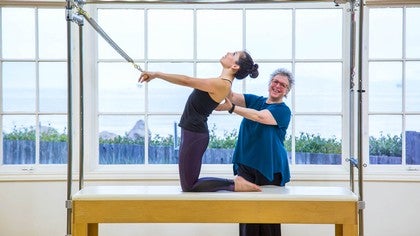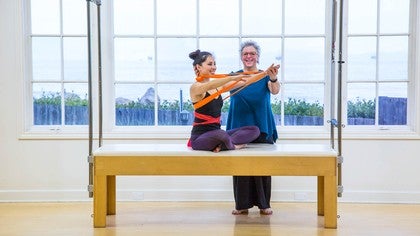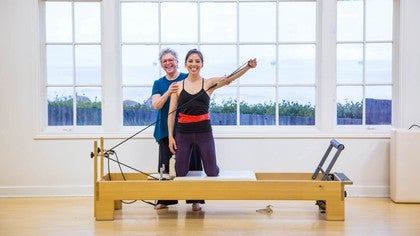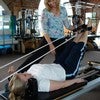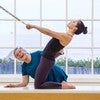Description
About This Video
Transcript
Read Full Transcript
So in this tutorial we're going to put everything together because in reality when we move, we just do not move as one muscle group. In our other tutorials, we broke it down. So there are times we need to wake our clients up on certain understanding and then we want to bring it back to the full coordination. If I don't have my spine, it also affects my shoulder girdle. So if you see I have upward rotation of my shoulder blade, but if I live with my spine here, it looks like my shoulder is up and within that's happening with the new education. Some of it's still old. I mean if you look at Jada, Jada was talking about full body movement and coordination of lower cross system, um, upper cross system. You have, uh, Tom Meyers with anatomy trains you before Tom Myers, there was a whole system of slings and that's, we're going to really talk about the anterior sling and the posterior sling, which is going to really help the coordination of the arm.
So we're going to review again, so we're gonna have you come up and bring your arm up. And so remember we were always talking about that. If you see her do this movement, she's doing great is that when she gets that shoulder blade in upward rotation, her shoulder drops. The other thing we talked about too is that that clavicle, go ahead, is going to float up. There we go. And that also helps. So we, in the first tutorial we talked about bone rhythms.
Now we're going to review the anterior serratus. So she's gonna lie prone. The um, foam roll is in the middle of her thigh bone. So remember the cereus attaches to the mid, mid middle part of the shoulder blade, and they're like nine little slices that go and wrap around to nine rips. So she's going to do sternum drop and I want all the ribs, all nine ribs to float up, and especially her first red, great, and sternum drop. And then you're going to press out, if I put my hands here, she's doing a little bit of lat. So make a fist and drive your, your forearm down and forward. And there we go. There we go.
And lift that first rib up. Then w w, uh, in the second, uh, tutorial, we talked about triceps. So sternum drop, flat hands. Now she's going to give me that serratus connection. And now without losing that beautiful wrap of her shoulder blade, she's gonna lift her elbows up, lift up your breastbone and lengthen. There we go. And then lower down.
Now just to review just a sternum drive. Gimme bad version. Keep now lift your elbows up and do you see how it goes up into her shoulder? So that coordination of working the Serratus with your triceps is very important. We also talked about too, so she has this gray top. Here's the spine of her shoulder blade. And right where this top is starting in end is her lower trapezius.
It's, it's like it's skin that's going down or back. It's so light so that when she lifts up, she gives me Cereus, she lifts her elbows up and this skin lightly goes into her spine. So there she has even better shoulder stability and this wide shoulder girdle and then come back down. So now let's have you come to sitting and, um, we're going to show you through therabands how we're gonna coordinate through the core. So if you look and you can see through some of my, uh, drawings, the Cereus interdigitates with your external obliques, and then it goes down through your internal obliques and they're calling that the anterior slick.
It's a wonderful concept because a lot of times, you know, as a dancer, you know, this was the problem and they said, knit your ribs together and pull your sternum down. Well, you can see it's changing my shoulder girl. But if I can think of these lines sliding shorter, that's my corset. That brings a three dimensional stability instead of just a front stability. So we're putting a this theraband on, oh, I forgot one thing. Um, well let's do this. You're going to put this theraband around and she's going to reach her elbows here.
Now this theraband is also representing her throat because a lot of our clients are living with their heads forward. So again, if my head is forward, I could be the smartest girl in the world or man. Um, but see when I bring my throat back it changes my head tail connection, so I want her to visualize the front of her throat meeting the theraband, so these are, this thera-band is like the road for her shoulder blade, so she reaches out the tip of the shoulder blade, slides to the elbow and the elbow slides to the head and reaches and then you're going to come back and then just bring your arm down. We're going to give her a little more sense of why clavicles because a lot of our clients when they start to straighten their arms, they let that humeral head go forward, which then is downward rotation. So remember when we started the session, we want that humeral head lightly back and then the shoulder blade is sliding and we're just going to give her like a little feeling of it, that bone, same bat and then she's going to straighten her elbows, not from here, but from her tricep and then bring it back down. Now we're going to give you another visual of that. Here is your external and internal obliques.
Okay. We're going to tie her up with a bow and I'm being very loose with these therabands. I'm using them more as proprioception. But if I was her core and I was to slide those, I'm going to call them sashes shorter. That's her courses. So when she stretches her arm forward, there's that. We'll keep her spine in the right place.
Now let's have a look at a quadro pit. So here again if you can, matter of fact, give me bad version. So just slump show, she looks hyperextended and you know a lot of times the cue was to pull your ribs down. Yes. But if you see or hear her shoulder blades are kind of together and if I was to touch kind of on the side seams, I don't feel much cereus. And then when I feel I just, it's kind of like this quality, it's not a big thing. But once you get that shoulder blade sliding around the ribs and then you put your fingertips lightly to her side ribs, you can feel that tone, hug her ribs.
Now you can see she's trying to get a little extension by doing a head flip, but we want to bring her front or throat up against that. So now she has a great uh, connection. Now here's the thing is here's the tip of the shoulder blade connecting to the rib. And then I want her to visualize how that diagonal is like a beam or a support for her spine. Her spine is the, and the therabands represents the beam. So when she lifts her left arm forward, she has to keep those sashes going. And there you go.
And going back down, what you see a lot of times is a drop out of your this. And now lift that arm up and do a lot of times here, her strategy is to pull down on this side or some of your clients they pull down in the ribs. Yes. And so what we want to get to is lift your first rib up, is that feeling of this support holding her and yes, one, one of the sashes is going to have to work differently when you make an uneven movement, reach the one arm fall or not high. There we go. And that's her support. Now I want to have us look at push row.
So we're going to have her straddle the machine and she's going to go, what? Yeah. And you're going to put your hands there. There you go. So right now she looks a little arched. We're going to bring her throat gently back. And that's if you look at her ears kind of, that's where spine ends up in her head.
That I want her to visualize the tip of the shoulder blades. Thumbs. And you can do it like, uh, that's it. Uh, she's gonna sit back. She thinks. There you go. But leg length. There we go. So pull your elbows down.
She's starting to pull down and I want her to think that if we could current hurt her spine forward, but she still has this end here slang, so she's not flopping. She's gonna roll back. You got to keep that tip of the shoulder blade. There we go. Parallel arms throw back and up. And then I'm going to ask her to just shave her arms there.
We want to keep an upward rotation and the rest of the movement at the hip socket. Oh, she's doing it from her back up. She's doing it. There you go. So what happens a lot of times is when people push forward, they do this. And so what I want you to sit, my back is wide. I'm lengthening and I still have my anterior slang. So you're going to keep your shoulder blades rapping and you're going to lengthen your ribs up. There we go. There we go.
So that she has legs in extension and then she's going to bring the whole thing back and through. Great. Now I want her to come back to quadrupedal. So if we go also, um, let's have you sit up. I'm, I'd lied. Sit facing forward and reach your arms out wide again. So if we look at the shoulder girdle, it's like a yoke.
Do you see? And so that if I think about the hand connecting to the breastbone and the hands connecting to my sacrum, that's also good. And bring the anterior sling in really well. And especially when we go into like, um, elephant, downward dog plank pose, getting that connection. Can they teach you about length and phenomenal support.
So come back to all fours and walk your hands a little forward. There you go. So we're going to have her do sternum drop. She's going to push off and widen. And the tip of the shoulder blade, there we go. So she has a beautiful flection. We're gonna ask her to squat backwards and I'm going to ask her to give me a better feeling of the crisscross. It's not a down, it's a criss cross. Tuck your toes under. And I want to, let's watch what she does when she goes a downward dog. Now what's neat about this theraband, she's doing a great job is if she lost her shoulder blade, meaning she lets it come in, this would start sliding off.
So here this wrap is getting the feeling of that terrain is and then it's connecting across to there. And then is she pushes, what I want her to connect is I'm putting my, I want her to imagine her hands pushes her sacrum up. There we go. Because a lot of times, and she's beginning to do it, a lot of people get closer because they hyper extend and you want to keep, connect your hands to your tailbone and feel it lengthen but stay supported. So push harder and get, uh, there we go. And so then she has a beautiful line here and then you see her shoulder blades are, are, are wide. Schlump do you see what happens now? Push with that.
Keep it slumped and push. And do you see how, what happens to her back? So that's where this whole coordination can really change your practice. Let's have her come down. Um, I'm going to take off the her toys, but she has to still imagine the toys. It will keep the Sasha. Let's have you go from downward dog to plank posts.
So here you are. That first rip. Go Up to downward dog. Keep that wide shoulder blade and now you're going to move forward to plank pose. And I, she all have to walk for a length in that breastbone length in that breastbone. There you go. She's a little short. Walk your feet back more. Now I want her to lift all the ribs up. Nod her head. Go back to downward dog. Stay better shoulder blades.
Not Rapping, rapping, rapping, rapping. Then is it a bird? Is it a plane? It's a breastbone. Go flying forward. Fly. Fly first rib up first rib up. Beautiful. She needs a little more legs, but that's it. And then go back into child's pose.
So there's a whole example of trying to bring everything in to bring a full body action, which is what's so beautiful about [inaudible]. But there's ways that in the past the accused really cha changes the connection. It really ruins a coronation. So if I'm pulling my armpits down, I'm not going to get to that anterior sling line come up and I want you to face, uh, you're back to the camera. So what I want you to think about in your practice is here is the shoulder blade. It's an upward rotation. And I'm going to ask you to back off where your arms are until you know your shoulder blades is working with your hand. So that is she, she's very successful right now about having a wide back.
A lot of times what you see, they, you, you're, it's great. And then you go to your bad habit. And so I want you to get observing, oh, do I have a wide shoulder blade? Do I have a wide clavicle? As you change your phrasing. Eventually she, if she keeps that tip of the shoulder blade there, she's going to be able to, she's doing great. Of course, if I go back more, it will close in, but a lot of times, even when you did downward dog, if I'm this way, I stretch my lots in a different way compared to when I have my arm, good shoulder blades.
And then it also relates to standing because if you're constantly shortening your lights and you try to do this, you're gonna have either hyperextend or your shoulders go up. And so I'm going to just say is there's times what I'm seeing is I want to go to where I have my beautiful y clavicle and shoulder blade and stop before I do the bad habit. Because once you get the phrasing correct, it's gonna Change your arm work and it's going to change your core.
Embodied Anatomy: Upper Body
Comments
You need to be a subscriber to post a comment.
Please Log In or Create an Account to start your free trial.
